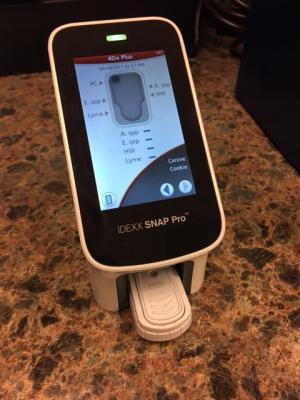How does my pet get heartworms?
- posted: Apr. 18, 2017
How does my pet get heartworms?
By Doctor Christa Young, DVM
Summer and daily rain are quickly approaching bringing one tiny creature that all of humanity dreads: mosquitos! We all know the annoying high-pitch buzzing that precedes their attack, followed by days of mind-unravelling itchiness.
The warm, wet weather fosters these little buggers and that means health risks for us and our pets. Dogs and cats can harbor West Nile Virus, while humans and horses can become deathly ill with exposure.
Many people and pets are actually allergic to mosquito bites leading to miserable summer un-fun.
 Perhaps the most important mosquito-borne disease for dogs and cats is heartworm infection. Baby heartworms, called microfilaria, develop in the mosquito and are transferred to our pets when taking a blood meal.
Perhaps the most important mosquito-borne disease for dogs and cats is heartworm infection. Baby heartworms, called microfilaria, develop in the mosquito and are transferred to our pets when taking a blood meal.
The baby heartworms move through body tissues and within 6-7 months mature into adults in the bloodstream. They can live for 5-7 years and wreak havoc on the lungs and heart muscle, eventually causing heart failure and death. An infected pet is bitten by a mosquito that carries the infection forward. Here in Florida, mosquitos are everywhere and they can get into our homes when doors are open to bring in groceries, or when tiny tears in the porch or window screens exist.
Cats can die from a single heart worm, and they cannot tolerate treatment (the drug is usually fatal). This makes prevention critical. Cats that get sick with heartworms develop a condition called Heartworm-Associated Respiratory Disease, or HARD for short. It's like constantly having an asthma attack. This is really the only outward sign a pet owner or veterinarian may see to suggest a problem exists. It is not unusual for a cat to experience sudden death when infected with heartworms.
Dogs can harbor several heartworms before losing the battle against effects of the disease. We do have a couple options for removal of the adult heartworms should a pet become infected. More on treatment options to follow in part II, with prevention in part III.
Dogs in early stages of heartworm disease have subtle and non-specific symptoms like: weight loss, occasional vomiting, changes in energy level, and a dull, flaky coat. As the worms cause more and more damage to the lungs and heart, the pet experiences: coughing, shortness of breath, sluggishness, muscle wasting, weakness, bloated belly, fluid in the lungs with gasping breaths, fainting episodes, blood clots, and death.
Okay, this is a nasty parasite spread by an all-to-common bug in the Gulf States. Here is a map showing where heartworm cases were reported last year. (Remember that this is just the reported cases! Animals who were not tested were not included!) So how do we check for this parasite and prevent it?
Ever wonder what we do with those few drops of blood collected during your dog's vaccine or wellness visit?
Depending on your dog's age and parasite preventative history, your veterinary team runs one or two types of tests:
 1. A test for adult heartworm proteins (aka SNAP test). The picture to the right is our testing machine which is showing a negative test result. (The test also tests for other bloodborne issues at the same time.)
1. A test for adult heartworm proteins (aka SNAP test). The picture to the right is our testing machine which is showing a negative test result. (The test also tests for other bloodborne issues at the same time.)
2. A Direct Buffy Coat Test for baby heartworms (aka microfilaria screen)
In cases of positive results, your veterinarian oftentimes will draw a larger blood sample to send to an outside lab for confirmation testing.
Testing in cats is challenging as several tests (protein and antibody SNAP tests) must be run including x-rays and heart ultrasound to confirm active heartworm infections.
As you can imagine, prevention is clearly the best option. With heartworm preventatives costing less than $80 for a year’s supply (often with rebates and other incentives), every dog and cat should be protected from this easy to catch, hard to kill parasite!
For more information, stay tuned for Doctor's next blog post about Heartworms or visit the American Heartworm Society.
Location
Find us on the map
Bellalago Veterinary Hospital
3809 Pleasant Hill Rd
Kissimmee, FL 34746, US

